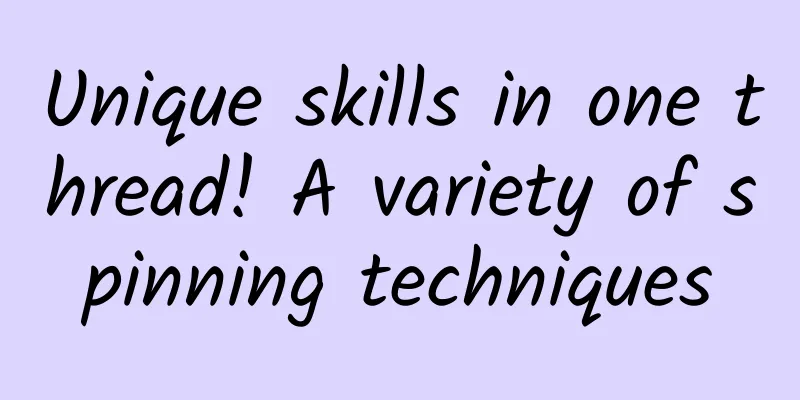Unique skills in one thread! A variety of spinning techniques

|
Part 1: Primitive Spinning Throughout the history of human development, people have used the bast, cotton, wool and other natural plants to spin yarn and weave cloth into clothes in order to keep warm. The spinning method has developed through exploration. 1. Primitive spinning: twisting with both hands Perhaps inspired by wild vines, the ancients discovered that natural plant fibers are mostly loose, and single fibers are short and thin, with low strength and not strong. In order to make them strong and durable, multiple fibers must be twisted and connected to increase strength and length. Thus, they gradually mastered the use of plant fibers such as bark, grass stems, jute, and cotton to manually twist them into ropes or yarns. 2. Primitive Spinning - Spindle The method of spinning yarn by twisting was too slow and uneven to meet the needs of weaving. After a long period of exploration, our ancestors invented spindles made of pottery, stone or iron, also known as spinning wheels or spinning reeds (fu), which used the rotating force of the spinning wheel to twist the fibers into yarn, increasing output and improving yarn quality. This has been discovered in archaeological excavations in my country and abroad (Figure 1 is a sketch of an iron spinning reed from the Western Han Dynasty unearthed in Changsha). Figure 1. Sketch of a Western Han Dynasty iron rod spinning rod unearthed in Changsha 3. Primitive Spinning - Hand-cranked (pedaled) Spinning Wheel The spindle is a simple stick, which later evolved into a spindle. The invention of the spinning wheel is a milestone in spinning technology. When spinning with a spinning wheel, the big wheel rotates once, driving the spindle to rotate 70 to 80 times; after the yarn is spun, it is reversed and wound around the spindle, which greatly improves production efficiency, 15 to 20 times higher than the spindle. Later, it was improved to a pedal spinning wheel. During the Anti-Japanese War, Yan'an launched a mass production campaign, and the hand-cranked spinning wheel made great contributions. Figure 2. Ancient Spinning Wheel Part 2: Traditional Spinning - Ring Spinning Ring spinning has a history of more than 100 years. The technology has been continuously improved, promoting the progress of the textile industry and society. It is called traditional spinning. The so-called "ring" is the steel collar, and the "spindle" is the spinning spindle. As shown in Figure 3, the spindle drives the bobbin to rotate. Under the tension of the yarn, the steel ring slides along the edge of the steel ring. With each turn, the yarn gets a twist. Due to the friction resistance, the speed difference between the steel ring and the spindle realizes the winding of the yarn. Ring spinning is a great progress in spinning technology, and the greatest invention is the steel ring and wire ring! Drafting, twisting and winding are carried out simultaneously, the mechanism is simple, continuous spinning, spinning speed and production efficiency are improved, which promotes the progress of spinning technology. Ring spinning technology is mature, suitable for a wide range of spinning, and the product is widely used. To this day, it still dominates various spinning methods. Compact spinning is also called condensed spinning. A fiber condensation (condensation) zone is added to the drafting device of the ring spinning frame, which basically eliminates the spinning twisting triangle area between the front roller and the twisting, and solves the drawbacks of traditional ring spinning, reduces yarn hairiness, and improves yarn strength. The yarn is used for high-end shirt fabrics, bedding, etc. Compact spinning is an improvement on traditional ring spinning, so it is called improved ring spinning. Figure 3. Schematic diagram of ring spinning (Figure: 1-drafting roller, 2-yarn guide hook, 3-bobbin, 4-wire traveler, 5-steel collar.) Part 3: New Spinning - Rotor Spinning Rotor spinning is a new spinning method that does not use spindles, steel collars, or wire rings. The fibers are condensed into yarns by centrifugal force and negative pressure under the action of the combing roller, spinning cup, false twist device, and other components. Rotor spinning is also called air spinning and is a type of open-end spinning. Spinning principle: Cotton strips are directly fed into the spinning machine and combed into single fibers by the combing roller. The fibers are separated from the surface of the combing roller by the centrifugal force of the combing roller and the negative pressure airflow in the spinning cup, and enter the spinning cup through the cotton transport tube, and form a complete fiber ring in the spinning cup condensation groove. The fiber ring rotates at high speed with the spinning cup, and under the pull of the joint yarn, the twist is transferred and the fiber bundles are continuously peeled off to form yarn. Characteristics of rotor spinning: 1) Shortened process, fewer roving and winding processes than ring spinning, and drawing can be done in one step. 2) Separation of drafting, twisting and winding, high spinning speed and production efficiency, early rotor spinning speed of 36,000 rpm, now up to 150,000 rpm. 3) Low requirements for fiber length, can spin low-grade cotton yarn. 4) Suitable for spinning medium and coarse yarn, yarn can be used for denim, knitwear, industrial and home textile products, etc. Fig. 4. Schematic diagram of rotor spinning. Part 4: New Spinning - Air-jet Vortex Spinning Air jet vortex spinning is a revolutionary reform of ring spinning. It retains roller drafting as super drafting, eliminates steel rings and wire rings, and adopts vortex twisting. The processing flow is shortened and the spinning speed is greatly increased. Spinning principle: Cotton slivers are fed in, and after being drawn, the slivers are output from the jaws of the front roller, and are immediately sucked in by the negative pressure generated by the vortex in the straight nozzle of the spinning machine to form core fibers. When the end of the fiber leaves the front roller, it expands due to the vortex, covers the surface of the hollow spindle, and rotates along the fixed hollow inner wall, and moves forward along the sliver. The fiber end is wrapped around the yarn core to give the sliver a twist and form yarn. Characteristics of air-jet vortex spinning: short process, reducing roving and winding steps; high spinning speed, more than 20 times that of traditional spinning machines, and high degree of automation, saving labor; the finished yarn has a similar appearance to ring yarn, but the yarn strength is lower than that of ring yarn, the yarn has good dryness, less hairiness, and is anti-pilling; it is suitable for spinning medium and fine yarns, and can spin all-cotton products, preferably spinning cotton-type chemical fibers, and is especially suitable for cellulose fibers and their blends. Figure 5. Schematic diagram of air jet vortex spinning There are four practical spinning methods in the field of spinning: traditional ring spinning, rotor spinning, air jet spinning and compact spinning, each with its own characteristics and yarn structure. Different spinning methods complement each other and provide more possibilities for the development of textile products. References: (1) Shanghai Institute of Textile Science, Textile History Editorial Group. Textile History. Shanghai Science and Technology Press, 1979. (2) Chen Zhong, Guo Jianhong, et al. Yarn structure and characteristics of different spinning methods. Textile Guide, 2003. |
>>: With 120 minutes left before sudden death from myocardial infarction, what else can we do?
Recommend
If you knew this earlier, would you still choose to whiten your teeth?
In today's age of white beauty, white skin an...
An article to thoroughly understand the Android event distribution mechanism
Preface In Android development, we often encounte...
Liu Feng丨Like humans, airplanes also get tired
In the experiment, The fuselage and wing structur...
Jiang Ziya's little secret! Did the small token help King Wu defeat King Zhou?
Communication in war is an extremely important li...
Wuhan University Sakura live broadcast schedule announced: When will it start and end? Attach specific time
March every year is the season to go to Wuhan to ...
How to improve SEO ranking? How to rank in the top three on the SEO homepage?
When you search for a certain keyword, there will...
The 100th launch! The Long March 4 series carrier rocket successfully launched the Fengyun-3-06 satellite
At 11:47 on August 3, 2023, my country successful...
The form of opening screen advertising!
Mobile advertising comes in many forms. For mobil...
How much does it cost to customize the Shihezi points mini program? What is the price quote for customizing Shihezi points app?
The factors affecting the quotation of Shihezi po...
Tik Tok short video eight resources video tutorial
Tik Tok short video eight resources video tutoria...
Arteta is diagnosed with the new coronavirus. Arsenal coach Arteta is diagnosed with the new coronavirus. The training base has been closed!
Live broadcast on March 13, according to official...
Operation skills and monetization methods of B station film and television accounts!
It is very easy to be an up master on Bilibili. A...
China Space Day丨The stars and the sea, never stop!
April 24 The 7th China Space Day Turn back the clo...
How should the routing antenna be placed to achieve faster Internet speed?
Recently, there has been a lot of controversy onl...
Taobao has changed its face! "Elderly Mode" officially launched before Double 11: bigger fonts and simpler operation
[[428293]] Some time ago, mainstream apps such as...









